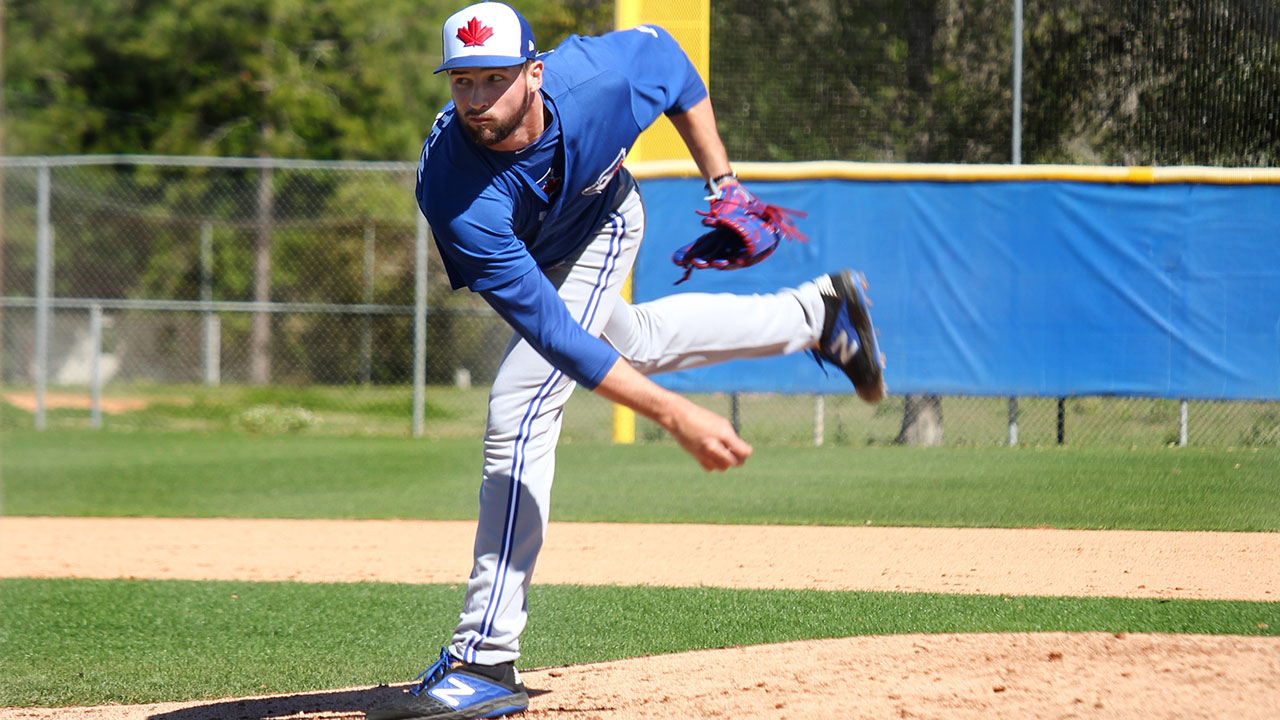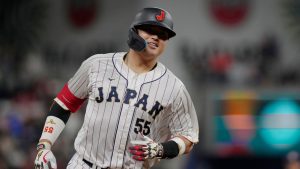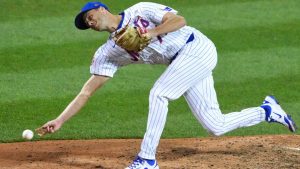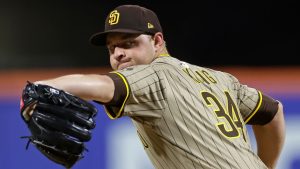There were the days he threw bullpens with Roger Clemens looking on, taking feedback between pitches from a seven-time Cy Young winner. There was the batting practice he spent shagging flyballs with Fernando Rodney, listening to a guy with 17 MLB seasons sermonizing on longevity. There were the former big-leaguers, the triple-A veterans, the one-time top prospects who provided daily advice from their own experiences over decades in the game — how to stay healthy, what to do on the way to the show, how to stick when you ultimately get there.
That’s how Adam Kloffenstein spent his summer. Faced with the possibility of losing an entire developmental season due to the COVID-19 pandemic, the Blue Jays pitching prospect played independent ball in the Constellation Energy League — a four-team, Texas-based circuit that featured the continent’s highest level of organized baseball outside MLB. Just 19, the league’s youngest player by four years, Kloffenstein went to get innings and salvage something of his 2020. He got an education.
“It was an experience to say the least,” Kloffenstein says. “I didn’t know what to expect going in. I’d never even played full-season ball. And now I’m walking into a locker room with triple-A and big-league guys. Guys who played over in Japan or Mexico and made all kinds of money. They’ve all got wives and kids. Some of these guys are old enough to be my dad.”
[snippet id=4722869]
Kloffenstein — selected in the third round of the 2018 draft and signed to a first-round bonus of $2.45-million — was meant to start 2020 with the class-A Lansing Lugnuts, possibly earning a promotion to high-A in the second-half of the season if things went well. But then the pandemic hit, halting minor-league spring training and forcing him home to Texas to work out, golf, and wait for the baseball world to start up again.
It was at the Houston facility where he trains during off-seasons that Kloffenstein first caught wind of what came to colloquially be known as “the COVID league.” You hear Roger Clemens is starting an indy league out in Sugar Land? Bunch of college guys; some minor-leaguers who were just released; a few guys with big-league time. Heard Roger’s meeting with the mayor about it. Heard he’s already got a hotel guys will be living in.
Kloffenstein — ranked as Toronto’s No. 4 pitching prospect by Baseball America — thought nothing of it. That league was for guys who didn’t have a team. He did and the Blue Jays had yet to release their 60-player pool for the 2020 season. Maybe he’d claim one of the final spots and spend his summer at the club’s alternate training site in Rochester, N.Y. He had his hopes up that he would. By June he was throwing live bullpens regularly to prepare.
But Kloffenstein just missed the cut behind fellow top pitching prospects Alek Manoah and Simeon Woods Richardson. The Blue Jays told him to stay ready — if someone got hurt or came down with COVID-19, Kloffenstein could be next in line to join the pool. But live bullpens get old after a while. And the COVID-league concept had advanced beyond mere speculation to an eight-week, 56-game schedule played at a nearby minor-league ballpark admitting more than 2,000 fans per game. Kloffenstein figured it couldn’t hurt to ask the Blue Jays if they’d let him spend his summer playing independent ball instead of waiting for a phone call that might never come.
Understandably, the club had questions. Who would be tracking his workload so he wasn’t overused? What kind of training staff and rehab facilities would he have access to? What precautions would be taken to prevent spreading the virus? There were a lot of risks and Kloffenstein figured he wouldn’t receive permission to play. But following a few days of deliberation, including conversations with league organizers, the Blue Jays came around to it.
“It was similar to the process we run with players going to winter ball. The first focus for all of us is, ‘OK, how can we help this player get better? How can we help keep him safe? How can we support him as much as possible through this?’” says Gil Kim, Toronto’s director of player development. “So, we looked at some of the safety protocols that the league had and then we put a plan together.”
Measures were taken to protect Toronto’s investment. Kloffenstein stayed at a hotel separate from the one hosting the rest of the league’s players in order to minimize risk of contracting the virus. His workload was carefully managed and he never threw more than three innings in an outing. The league sent TrackMan data and video to the Blue Jays after each of Kloffenstein’s starts so they could keep a close eye on how he was performing physically from afar.
Mentally, Kloffenstein was going through it. A season prior, when he made 13 starts with the low-A Vancouver Canadians, he was already three year’s young for the level. Now he was facing hitters who were in the majors a year before that when Kloffenstein was playing high school ball. One of the first batters he faced was Courtney Hawkins, a 2012 first-round pick and fellow Texan who Kloffenstein idolized as a 12-year-old.
“I never thought that I could face that guy. And I ended up breaking his bat,” Kloffenstein says. “My first couple outings, they went OK — but it was a little rocky. I was nervous. I was trying to be way too fine. I was trying to throw every pitch on the corner because I thought these guys were all the next coming of Christ.”
An early-season trade to a younger team made up largely of recent University of Texas graduates helped ease his nerves, putting Kloffenstein in an environment where he wasn’t the only young guy in the room. His new manager, Koby Clemens, was only 33. And his new pitching coach, Koby’s dad Roger, had a few stories to tell from the couple decades he spent as the game’s best pitcher.
“We talked about some interesting things with Roger. One day he threw a bullpen for us and in between each pitch he was telling us different things he’d do that kept him healthy throughout his career,” Kloffenstein says. “And that stuff spoke volumes to me. Because he was never hurt. And he was really good for a long time. I think that pitching 25 years and virtually never missing a start is just as impressive as seven Cy Youngs.”
Kloffenstein settled in from there and started attacking hitters more aggressively, trusting his ability and that he belonged. A particularly rough, six-run inning inflated his 4.64 COVID-league ERA. But he finished his time there with scoreless outings in five of his final eight appearances, striking out nearly a batter an inning.
[snippet id=3305549]
Along the way there were formative moments. One was when Dustin Peterson, a triple-A regular with a pair of MLB call-ups in his career, pulled Kloffenstein aside one day after facing him and told him he had great stuff, he just needed to attack hitters more purposefully. Another came while watching batting practice with Fernando Rodney, the 43-year-old veteran with 327 career saves who pitched one Constellation Energy League inning before signing with the Houston Astros.
“He was like, ‘I know you young guys these days, you all throw 100. But that doesn’t matter,’” Kloffenstein recalls. “’What matters is where you put the baseball. I don’t care how hard you throw. Because if you’re going to throw it down the middle, it’s going to get hit.’”
That speaks to him. Still growing and finally healthy after pitching through a shoulder impingement in 2019, Kloffenstein’s experienced a significant velocity jump over the last 12 months. His sinker’s been up to 97; his four-seamer, 99. His secondary weapons have ticked up in turn, with his slider and changeup now coming out around 90, which is a little firmer than he’d like. The extra velocity’s great, but often it’ll come at the detriment of command and effectiveness.
A focus this winter has actually been slowing his secondary pitches down, so he can locate more consistently and throw them with better action. Kloffenstein’s been toying with different grips and release points. Even fine details like how tight he holds the ball or where he sets his gaze on the catcher. He’s not complaining about the extra velocity. He’d just like to have it in reserve if he needs it rather than tapping into it all the time.
“It’s a great problem to have. A harder breaking pitch is harder to hit. But it also doesn’t break as much,” he says. “Finding that in-between where it can be on the harder side but still have a lot of movement is what we’re searching for.”
Kloffenstein spent two weeks at the Blue Jays player development complex in Dunedin, Fla., last month diving into the data on elite MLBers who throw pitches with similar characteristics to his. What grip do they use? Where’s their release point at? What parts of the zone are they effective in? When do they get barrelled?
One example is Blake Treinen, the Dodgers reliever who throws one of the game’s most effective sinkers — a 97-m.p.h. bowling ball that gives hitters fits because it breaks horizontally nearly as much as it drops vertically. Kloffenstein’s sinker behaves similarly and a recent focus has been studying Treinen’s video to pick up cues on where best to start the pitch, which parts of the zone to target against different hitters, and which spots to avoid.
Another was Marcus Stroman, who the Blue Jays have a stockpile of data on from the 146 outings he pitched for the team earlier in his career. Stroman’s sinker isn’t as firm as Treinen’s, but it still moves a ton — and he threw it as a starter, finding multiple ways to set it up and play it off the rest of his arsenal over multiple innings, which is what Kloffenstein will need to do someday.
His ultimate goal — a lofty one, Kloffenstein admits — is to have five 70-grade pitches as a big-leaguer. Four-seamer, sinker, slider, curveball, and changeup. A deep arsenal that will give him more options if one pitch or another isn’t working on a given night; that will let him turn a lineup over three times without ever giving the same hitter the same look.
That’s how workhorse starters like Justin Verlander, Trevor Bauer and Hyun-jin Ryu pitch. That’s how Clemens did it in his day. For Kloffenstein’s career to end up in the same bracket will be an incredible challenge. But why would he aim to be anything less?
“That’s where I want to be and that’s what I strive for,” he says. “I’ve got three pitches right now that are on their way to being elite big-league pitches. And I want to get the other two pitches up there, as well. Even if I end up with five 65-grade or 60-grade pitches, that’s still a good recipe for a guy that can go deep into ballgames.”
[snippet id=4939894]
So, who said 2020 had to be a lost developmental season? Arguably, Kloffenstein gained more experience playing independent ball than any of the young Blue Jays who spent their summer at the club’s alternate training site. There, pitchers threw live batting practice to the same small group of hitters over and over surrounded by empty stands. In Texas, Kloffenstein pitched before crowds in real games against more experienced, varied competition.
And that’s not to mention the abstract benefit of sharing a clubhouse with players who have made it to MLB, picking their brains and learning from their experiences. Not many pitchers two years out of high school get to compare notes with Fernando Rodney. Not a lot of 20-year-old prospects have Roger Clemens’ number in their phone.
“There was just a lot of intangible things that I learned down there. Listening to stories, getting advice, hearing their feedback on my stuff,” he says. “It was a good atmosphere to be around. It was a lot of fun. It’s obviously something I hope I never have to do again. But I think it was really beneficial.”
[relatedlinks]





